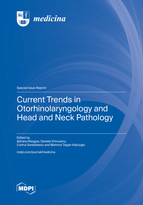Current Trends in Otorhinolaryngology and Head and Neck Pathology
A special issue of Medicina (ISSN 1648-9144). This special issue belongs to the section "Surgery".
Deadline for manuscript submissions: closed (20 July 2023) | Viewed by 41299
Special Issue Editors
Interests: ENT pathology; imaging modalities; sleep apnea and quality of life; allergic reactions; implants in ENT and head and neck pathology; cochlear implants; ear surgery; artificial intelligence; translation of interdisciplinary management into current practice
Special Issues, Collections and Topics in MDPI journals
Interests: oncology—head and neck surgery; artificial intelligence; interdisciplinary management into current practice; rhinology; allergy
Special Issues, Collections and Topics in MDPI journals
Interests: imaging; allergy; rhinology and skullbase; treatment of ENT pathology; interdisciplinary management into current practice; implants in ENT and head and neck pathology; sleep medicine
Special Issues, Collections and Topics in MDPI journals
Interests: ENT pathology treatment; imaging ENT; sleep apnea; allergy; implants in ENT and head and neck pathology; artificial intelligence; cochlear implant; ear surgery
Special Issues, Collections and Topics in MDPI journals
Special Issue Information
Dear Colleagues,
Otorhinolaryngology and head and neck specialists worldwide face an increasing incidence and prevalence of various pathologies, some of the cases neglecting the evolution of their condition during the period of COVID-19 pandemics, and thus aggravating their evolution. We are pleased to invite you to contribute to this Special Issue with manuscripts reflecting current trends in ENT and HNS. We welcome original articles, but also reviews and selected rare case series to update the protocols of ENT and allied specialists worldwide during the aftermath of the COVID-19 pandemic.
This Special Issue aims to refresh the knowledge on the numerous branches of pathology that contribute to the high complexity of our medical practice.
Dr. Adriana Neagos
Dr. Daniela Vrinceanu
Prof. Dr. Codrut Sarafoleanu
Prof. Dr. Mahmut Tayyar Kalciogu
Guest Editors
Manuscript Submission Information
Manuscripts should be submitted online at www.mdpi.com by registering and logging in to this website. Once you are registered, click here to go to the submission form. Manuscripts can be submitted until the deadline. All submissions that pass pre-check are peer-reviewed. Accepted papers will be published continuously in the journal (as soon as accepted) and will be listed together on the special issue website. Research articles, review articles as well as short communications are invited. For planned papers, a title and short abstract (about 100 words) can be sent to the Editorial Office for announcement on this website.
Submitted manuscripts should not have been published previously, nor be under consideration for publication elsewhere (except conference proceedings papers). All manuscripts are thoroughly refereed through a single-blind peer-review process. A guide for authors and other relevant information for submission of manuscripts is available on the Instructions for Authors page. Medicina is an international peer-reviewed open access monthly journal published by MDPI.
Please visit the Instructions for Authors page before submitting a manuscript. The Article Processing Charge (APC) for publication in this open access journal is 1800 CHF (Swiss Francs). Submitted papers should be well formatted and use good English. Authors may use MDPI's English editing service prior to publication or during author revisions.
Keywords
- otorhinolaryngology
- pathology
- imaging
- surgery
- treatment
- oncology
- apnea
- allergy
- artificial intelligence
- interdisciplinary
- ear
- cochlear implant







